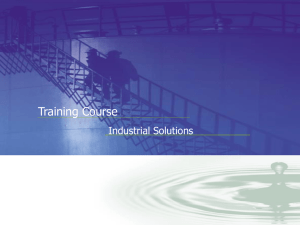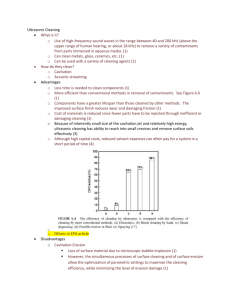Class 11 – Level measurement - UJ
advertisement
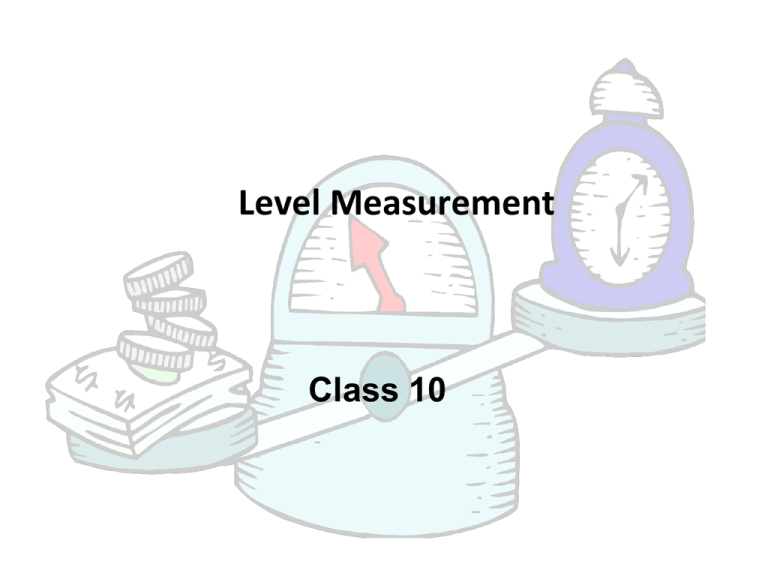
Level Measurement Class 10 Introduction A wide variety of instruments are available for measuring the level of liquids. Some of these can also be used to measure the levels of solids that are in the form of powders or small particles. In some applications, only a rough indication of level is needed, and simple devices such as dipsticks or float systems are adequate. However, in other cases where high accuracy is demanded, other types of instrument must be used. The sections below cover the various kinds of levelmeasuring device available. The available level-measuring devices are: Dipsticks, Float systems, Pressure-measuring devices (Hydrostatic systems), Capacitive devices, Ultrasonic level gauge, Radar (microwave) methods, and Radiation methods. Other Techniques (less popular) include: Vibrating level sensor, Hot wire elements, Laser methods, Fiber-optic level sensor, and Thermography. Intelligent Level-measuring Instruments. The Choice between different level sensors. Dipsticks Dipsticks offer a simple means of measuring level approximately. The ordinary dipstick is the cheapest device available. This consists of a metal bar on which a scale is etched. The bar is fixed at a known position in the liquidcontaining vessel. A level measurement is made by removing the instrument from the vessel and reading off how far up the scale the liquid has wetted. As a human operator is required to remove and read the dipstick, this method can only be used in relatively small and shallow vessels. Dipsticks The optical dipstick is an alternative form that allows a reading to be obtained without removing the dipstick from the vessel, and so is applicable to larger, deeper tanks. Light from a source is reflected from a mirror, passes round the chamfered end of the dipstick, and enters a light detector after reflection by a second mirror. When the chamfered end comes into contact with liquid, its internal reflection properties are altered and light no longer enters the detector. By using a suitable mechanical drive system to move the instrument up and down and measure its position, the liquid level can be monitored. Float systems Float systems, whereby the position of a float on the surface of a liquid is measured by means of a suitable transducer, have a typical measurement inaccuracy of ±1%. This method is also simple, cheap and widely used. The system using a potentiometer is very common, and is well known for its application to monitoring the level in motor vehicle fuel tanks. Float systems An alternative system, which is used in greater numbers, is called the float and tape gauge (or tank gauge). This has a tape attached to the float that passes round a pulley situated vertically above the float. The other end of the tape is attached to either a counterweight or a negativerate counter-spring. The amount of rotation of the pulley, measured by either a synchro or a potentiometer, is then proportional to the liquid level. These two essentially mechanical systems of measurement are popular in many applications, but the maintenance requirements of them are always high. Pressure-measuring devices The hydrostatic pressure due to a liquid is directly proportional to its depth and hence to the level of its surface. Several instruments are available that use this principle, and they are widely used in many industries, particularly in harsh chemical environments. In the case of open-topped vessels (or covered ones that are vented to the atmosphere), the level can be measured by inserting a pressure sensor at the bottom of the vessel. The liquid level h is then related to the measured pressure P according to h = P /ρ g, where ρ is the liquid density and g is the acceleration due to gravity. One source of error in this method can be imprecise knowledge of the liquid density. This can be a particular problem in the case of liquid solutions and mixtures (especially hydrocarbons), and in some cases only an estimate of density is available. Even with single liquids, the density is subject to variation with temperature, and therefore temperature measurement may be required if very accurate level measurements are needed. Pressure-measuring devices Where liquid-containing vessels are totally sealed, the liquid level can be calculated by measuring the differential pressure between the top and bottom of the tank. The differential pressure transducer used is normally a standard diaphragm type, although silicon-based microsensors are being used in increasing numbers. The liquid level is related to the differential pressure measured, δP, according to h = δP /ρ g. The same comments as for the case of the open vessel apply regarding uncertainty in the value of ρ. An additional problem that can occur is an accumulation of liquid on the side of the differential pressure transducer that is measuring the pressure at the top of the vessel. This can arise because of temperature fluctuations, which allow liquid to alternately vaporize from the liquid surface and then condense in the pressure tapping at the top of the vessel. The effect of this on the accuracy of the differential pressure measurement is severe, but the problem is easily avoided by placing a drain pot in the system. Pressure-measuring devices A final pressure-related system of level measurement is the bubbler unit. This uses a dip pipe that reaches to the bottom of the tank and is purged free of liquid by a steady flow of gas through it. The rate of flow is adjusted until gas bubbles are just seen to emerge from the end of the tube. The pressure in the tube, measured by a pressure transducer, is then equal to the liquid pressure at the bottom of the tank. It is important that the gas used is inert with respect to the liquid in the vessel. Nitrogen, or sometimes just air, is suitable in most cases. Gas consumption is low, and a cylinder of nitrogen may typically last for six months. The method is suitable for measuring the liquid pressure at the bottom of both open and sealed tanks. It is particularly advantageous in avoiding the large maintenance problem associated with leaks at the bottom of tanks at the site of the pressure tapings required by alternative methods. Measurement uncertainty varies according to the application and the condition of the measured material. A typical value would be ±0.5% of fullscale reading, although ±0.1% can be achieved in some circumstances. Pressure-measuring devices Pressure Transducer Differential Pressure Transducer Bubbler Unit Capacitive Devices Capacitive devices are widely used for measuring the level of both liquids and solids in powdered or granular form. They perform well in many applications, but become inaccurate if the measured substance is prone to contamination by agents that change the dielectric constant. Ingress of moisture into powders is one such example of this. They are also suitable for use in extreme conditions measuring liquid metals (high temperatures), liquid gases (low temperatures), corrosive liquids (acids, etc.) and high pressure processes. Two versions are used according to whether the measured substance is conducting or not. For non-conducting substances (less than 0.1 μmho/cm3), two bare-metal capacitor plates in the form of concentric cylinders are immersed in the substance. The substance behaves as a dielectric between the plates according to the depth of the substance. Capacitive Devices For concentric cylinder plates of radius a and b (b > a), and total height L, the depth of the substance h is related to the measured capacitance C by: where ε is the relative permittivity of the measured substance and ε0 is the permittivity of free space. In the case of conducting substances, exactly the same measurement techniques are applied, but the capacitor plates are encapsulated in an insulating material. The relationship between C and h as in the previous equation has to be modified to allow for the dielectric effect of the insulator. Measurement uncertainty is typically ±(1–2)%. Ultrasonic Level Gauge Ultrasonic level measurement is one of a number of non-contact techniques available. The principle of the ultrasonic level gauge is that energy from an ultrasonic source above the liquid is reflected back from the liquid surface into an ultrasonic energy detector. In alternative versions, the ultrasonic source is placed at the bottom of the vessel containing the liquid, and the time of flight between emission, reflection off the liquid surface and detection back at the bottom of the vessel is measured. Ultrasonic techniques are especially useful in measuring the position of the interface between two immiscible liquids contained in the same vessel, or measuring the sludge or precipitate level at the bottom of a liquid-filled tank. In either case, the method employed is to fix the ultrasonic transmitter–receiver transducer at a known height in the upper liquid. This establishes the level of the liquid/liquid or liquid/sludge level in absolute terms. Ultrasonic Level Gauge When using ultrasonic instruments, it is essential that proper compensation is made for the working temperature if this differs from the calibration temperature, since the speed of ultrasound through air varies with temperature. Ultrasound speed also has a small sensitivity to humidity, air pressure and carbon dioxide concentration, but these factors are usually insignificant. Temperature compensation can be achieved in two ways. Firstly, the operating temperature can be measured and an appropriate correction made. Secondly, and preferably, a comparison method can be used in which the system is calibrated each time it is used by measuring the transit time of ultrasonic energy between two known reference points. This second method takes account of humidity, pressure and carbon dioxide concentration variations as well as providing temperature compensation. With appropriate care, measurement uncertainty can be reduced to about ±1%. Ultrasonic Level Gauge Radar (Microwave) Methods Level-measuring instruments using microwave radar are an alternative technique for non-contact measurement. Currently, they are still very expensive (~ £3000), but prices are falling and usage is expanding rapidly. They are able to provide successful level measurement in applications that are otherwise very difficult, such as measurement in closed tanks, measurement where the liquid is turbulent, and measurement in the presence of obstructions and steam condensate. The technique involves directing a constant-amplitude, frequencymodulated microwave signal at the liquid surface. A receiver measures the phase difference between the reflected signal and the original signal transmitted directly through air to it. This measured phase difference is linearly proportional to the liquid level. The system is similar in principle to ultrasonic level measurement, but has the important advantage that the transmission time of radar through air is almost totally unaffected by ambient temperature and pressure fluctuations. However, as the microwave frequency is within the band used for radio communications, strict conditions on amplitude levels have to be satisfied, and the appropriate licenses have to be obtained. Radar (Microwave) Methods Radiation Methods The radiation method is an expensive technique, which uses a radiation source and detector system located outside a liquid-filled tank. The noninvasive nature of this technique in using a source and detector system outside the tank is particularly attractive. The absorption of both beta rays and gamma rays varies with the amount of liquid between the source and detector, and hence is a function of liquid level. Caesium-137 is a commonly used gamma-ray source. The radiation level measured by the detector I is related to the length of liquid in the path x according to: where I0 is the intensity of radiation that would be received by the detector in the absence of any liquid, μ is the mass absorption coefficient for the liquid and ρ is the mass density of the liquid. In the following arrangement, the radiation follows a diagonal path across the liquid, and therefore some trigonometrical manipulation has to be carried out to determine the liquid level h from x. Radiation Methods Apart from use with liquids at normal temperatures, this method is commonly used for measuring the level of hot, liquid metals. However, because of the obvious dangers associated with using radiation sources, very strict safety regulations have to be satisfied when applying this technique. Very low activity radiation sources are used in some systems to overcome safety problems but the system is then sensitive to background radiation and special precautions have to be taken regarding the provision of adequate shielding. Because of the many difficulties in using this technique, it is only used in special applications. Other Techniques: Vibrating level sensor The principle of the vibrating level sensor is simple. The instrument consists of two piezoelectric oscillators fixed to the inside of a hollow tube that generate flexural vibrations in the tube at its resonant frequency. The resonant frequency of the tube varies according to the depth of its immersion in the liquid. A phase-locked loop circuit is used to track these changes in resonant frequency and adjust the excitation frequency applied to the tube by the piezoelectric oscillators. Liquid level measurement is therefore obtained in terms of the output frequency of the oscillator when the tube is resonating. Other Techniques: Hot-wire elements/carbon resistor elements This level-measuring system uses a series of hotwire elements or carbon resistors placed at regular intervals along a vertical line up the side of a tank. The heat transfer coefficient of such elements differs substantially depending upon whether the element is immersed in air or in the liquid in the tank. Consequently, elements in the liquid have a different temperature and therefore a different resistance to those in air. This method of level measurement is a simple one, but the measurement resolution is limited to the distance between sensors. Other Techniques: Laser methods One laser-based method is the reflective level sensor. This sensor uses light from a laser source that is reflected off the surface of the measured liquid into a line array of charge-coupled devices. Only one of these will sense light, according to the level of the liquid. An alternative, laser-based technique operates on the same general principles as the radar method described above but uses laser generated pulses of infrared light directed at the liquid surface. This is immune to environmental conditions, and can be used with sealed vessels provided that a glass window is provided in the top of the vessel. Other Techniques: Fiber-optic level sensors The fiber-optic cross-talk sensor is one example of a fiber-optic sensor that can be used to measure liquid level. Another light-loss fiber-optic level sensor is the simple loop sensor shown in Figure (a). The amount of light loss depends on the proportion of cable that is submerged in the liquid. This effect is magnified if the alternative arrangement, shown in Figure (b), is used, where light is reflected from an input fiber, round a prism, and then into an output fiber. Light is lost from this path into the liquid according to the depth of liquid surrounding the prism. Other Techniques: Thermography Thermal imaging instruments are a further means of detecting the level of liquids in tanks. Such instruments are capable of discriminating temperature differences as small as 0.1°C. Differences of this magnitude will normally be present at the interface between the liquid, which tends to remain at a constant temperature, and the air above, which constantly fluctuates in temperature by small amounts. The upper level of solids stored in hoppers is often detectable on the same principles. Intelligent Level-measuring Instruments Most types of level gauge are now available in intelligent form. The pressure-measuring devices are obvious candidates for inclusion within intelligent level-measuring instruments, and versions claiming ±0.05% accuracy are now on the market. Such instruments can also carry out additional functions, such as providing automatic compensation for liquid density variations. Microprocessors are also used to simplify installation and set-up procedures. Choice between different level sensors Two separate classes of level sensors can be distinguished according to whether they make contact or not with the material whose level is being measured. Contact devices are less reliable for a number of reasons, and therefore non-contact devices such as radar, laser, radiation or ultrasonic devices are preferred when there is a particular need for high reliability. According to the application, sensors that are relatively unaffected by changes in the temperature, composition, moisture content or density of the measured material may be preferred. In these respects, radar (microwave) and radiation sensors have the best immunity to such changes.

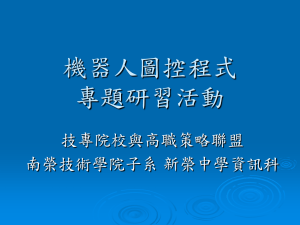
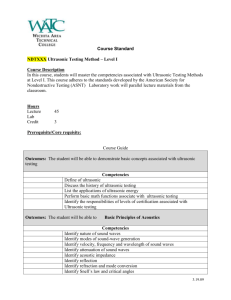
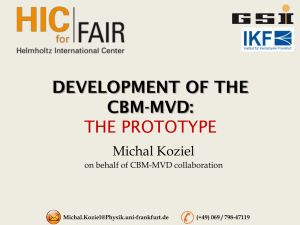



![Jiye Jin-2014[1].3.17](http://s2.studylib.net/store/data/005485437_1-38483f116d2f44a767f9ba4fa894c894-300x300.png)
